Introduction to Car Design Evolution
The evolution of Trends in Car Design stands as a testament to human innovation and technological advancement. From the humble beginnings of motor vehicles to the sleek, aerodynamic machines of today, the journey of car design has been marked by a continuous strive for excellence and improvement. Over the decades, cars have evolved not just in their functionality but also in their aesthetics, reflecting the changing tastes, technological capabilities, and societal influences.
Innovations in Materials and Construction
Revolutionary advancements in materials and construction techniques have been pivotal in shaping the evolution of car design. The shift from traditional steel frames to lightweight yet sturdy materials like aluminum, carbon fiber, and composite materials has significantly impacted both the performance and aesthetics of vehicles. These innovations have not only enhanced fuel efficiency but also provided designers with newfound freedom to explore more daring and futuristic designs.
Functional Aesthetics in Modern Cars
The contemporary approach to car design emphasizes the fusion of functionality and aesthetics. Streamlined shapes, aerodynamic profiles, and intricate detailing serve not only an aesthetic purpose but also contribute to improved performance and efficiency. The marriage of form and function has led to the creation of vehicles that are not only visually appealing but also highly functional and efficient.
Fusion of Artistry and Engineering
Car design today embodies a harmonious blend of artistry and engineering precision. Designers combine their artistic vision with technological prowess to create vehicles that captivate both the eye and the mind. The intricate dance between creativity and technical feasibility results in cars that are not only aesthetically pleasing but also push the boundaries of what is possible in automotive engineering.
Cultural Influences in Car Aesthetics
Cultural influences play a profound role in shaping the aesthetics of cars. From the understated elegance of European designs to the bold and expressive styles of American automobiles, cultural nuances permeate through car design, reflecting societal values, trends, and aspirations. Globalization has further fueled a melting pot of influences, leading to diverse and eclectic design approaches.
Evolution of Brand Identity through Design
Car design serves as a powerful tool for expressing and evolving brand identity. Each automaker strives to carve a distinctive visual language that embodies its values, heritage, and aspirations. Iconic design elements and signature styling cues become synonymous with a brand, fostering brand recognition and loyalty among consumers.
Safety and Aesthetics: Interplay and Innovations
The integration of safety features into car design has undergone a significant transformation. What was once perceived as purely functional elements, such as airbags and crumple zones, are now seamlessly integrated into the overall aesthetic of vehicles. Designers ingeniously incorporate safety features without compromising on the visual appeal, ensuring that safety becomes an inherent part of the design language.
Trends in Exterior Car Design
Exterior car design trends continuously evolve, influenced by technological advancements, consumer preferences, and societal shifts. From the rise of sleek, minimalist designs to the resurgence of retro-inspired aesthetics, the exterior of cars reflects the dynamic nature of design trends. Bold colors, innovative lighting, and futuristic contours contribute to the ever-changing landscape of exterior car design.
Interior Innovations and Aesthetic Trends
The interior of cars has witnessed a revolution in design, with a focus on creating immersive and luxurious spaces. Cutting-edge technologies, ergonomic layouts, and premium materials redefine the driving experience. The interior design trends encompass everything from intuitive infotainment systems to customizable ambient lighting, elevating comfort and aesthetics within the vehicle.
Emotional Connection through Design
Car design goes beyond mere functionality; it strives to create an emotional connection with users. Design elements evoke feelings of excitement, nostalgia, or aspiration, fostering a strong emotional bond between the driver and the vehicle. The ability of car design to elicit emotions contributes significantly to brand loyalty and consumer satisfaction.
Cross-Industry Collaborations in Car Design
Collaborations between automotive companies and other industries have sparked innovative design concepts. Partnerships with fashion houses, technology companies, and even artists have led to groundbreaking designs that push the boundaries of conventional car design. These collaborations bring fresh perspectives and novel ideas, resulting in cars that are not just modes of transportation but works of art.
Consumer Trends Shaping Car Design
Consumer preferences and lifestyle trends play a pivotal role in shaping the direction of car design. The growing demand for eco-friendly vehicles, increased connectivity, and emphasis on personalization have steered designers to create cars that align with these evolving consumer needs. The ability to anticipate and adapt to these trends remains crucial for staying relevant in the automotive market.
Future Projections in Car Aesthetics
The future of car design holds exciting prospects, driven by advancements in technology, sustainability, and evolving societal norms. From the proliferation of electric and autonomous vehicles to the integration of AI-driven design processes, the landscape of car aesthetics is poised for a paradigm shift. Designers are tasked with balancing innovation with practicality, envisioning vehicles that not only meet future needs but also captivate with their aesthetics.
Conclusion: Embracing the Evolving Landscape of Car Design
As the automotive industry hurtles towards a future marked by innovation and transformation, embracing the evolving landscape of car design becomes imperative. The convergence of technological breakthroughs, artistic expression, and consumer demands propels car design into uncharted territories. With an unwavering commitment to innovation and an understanding of the interplay between aesthetics and functionality, car designers continue to shape the vehicles of tomorrow, promising an exhilarating journey for both creators and consumers alike.






